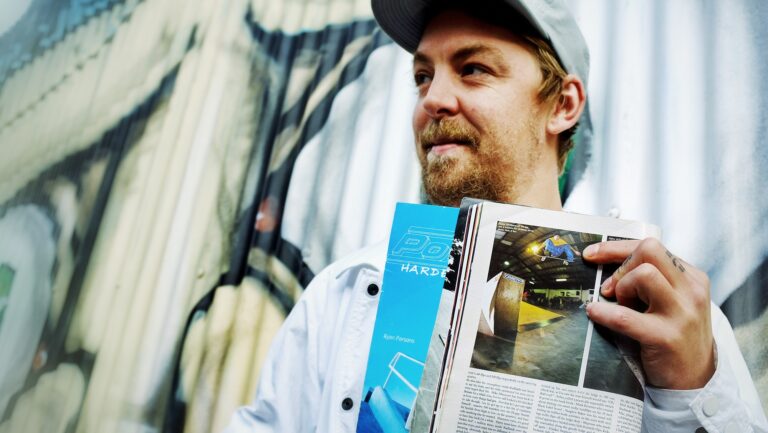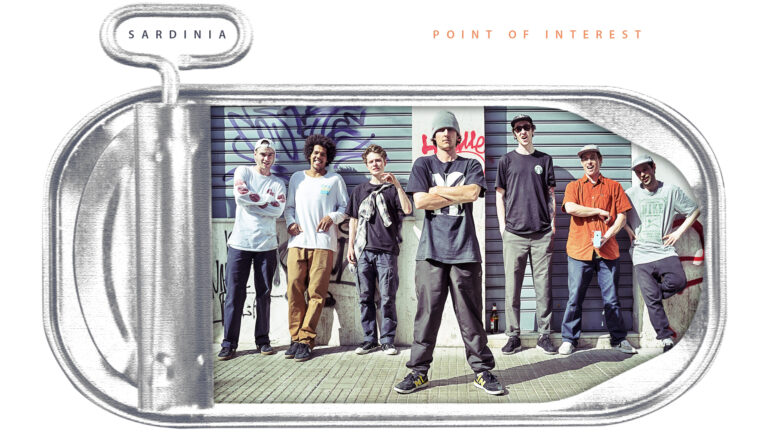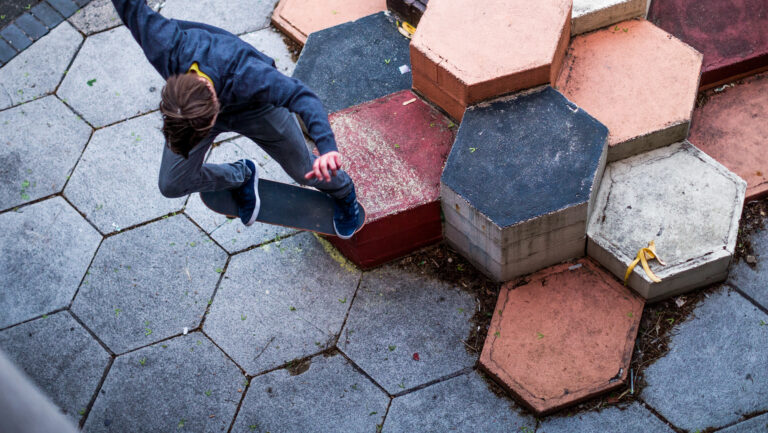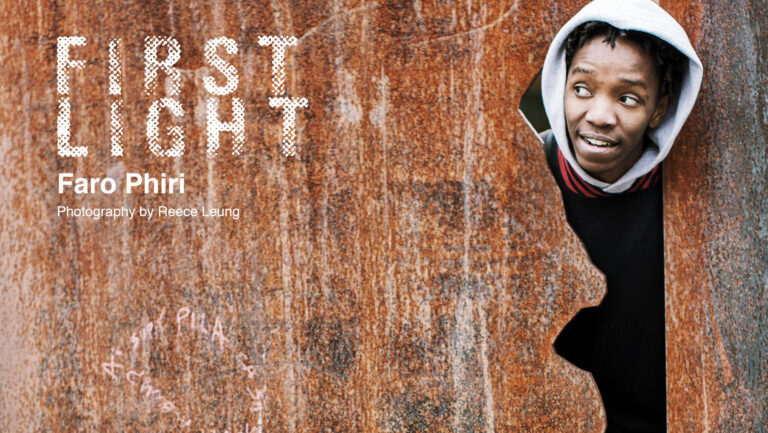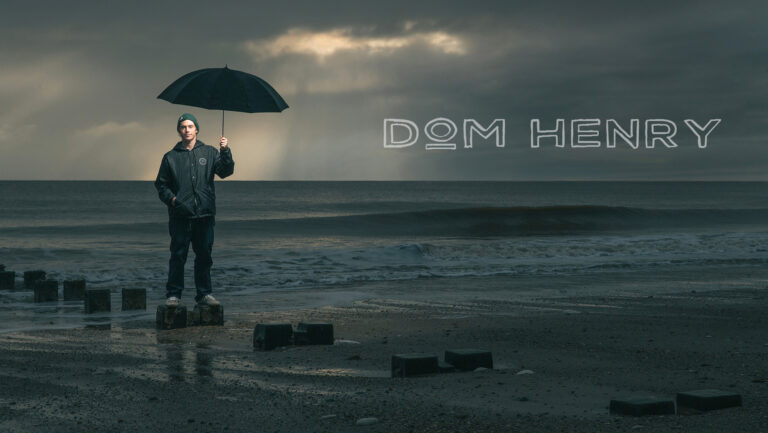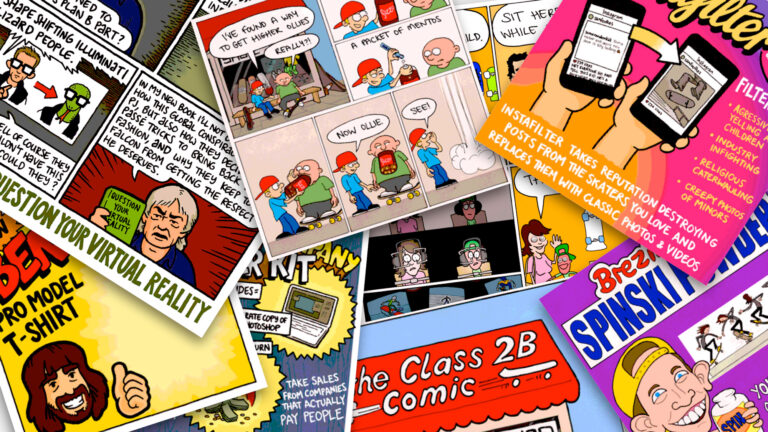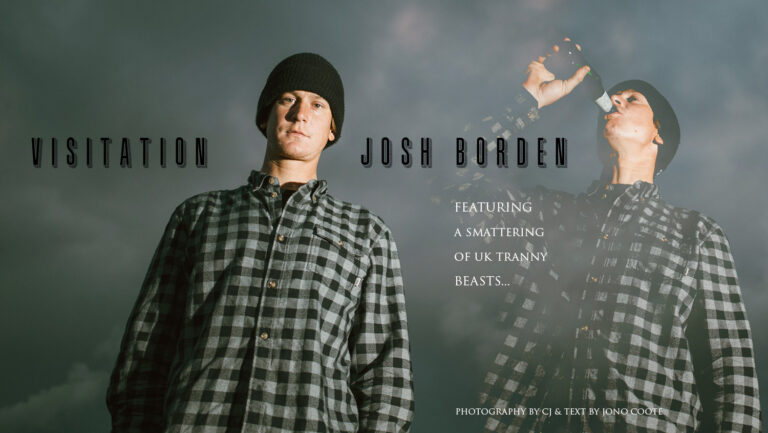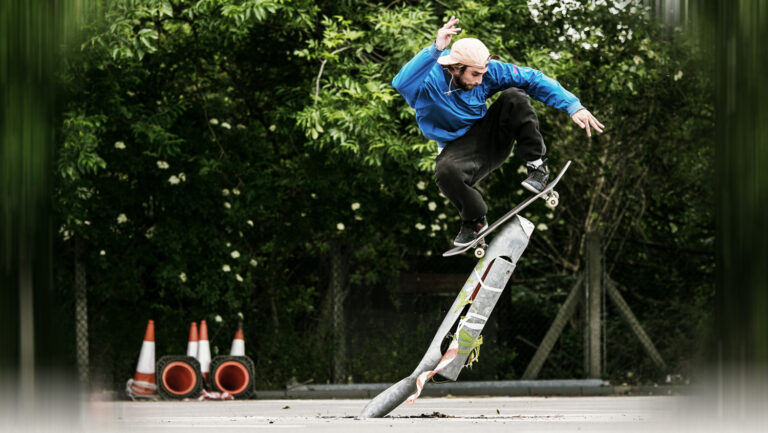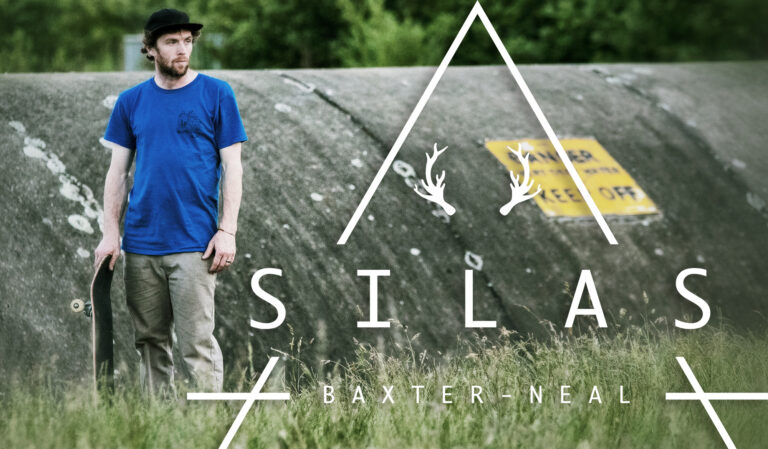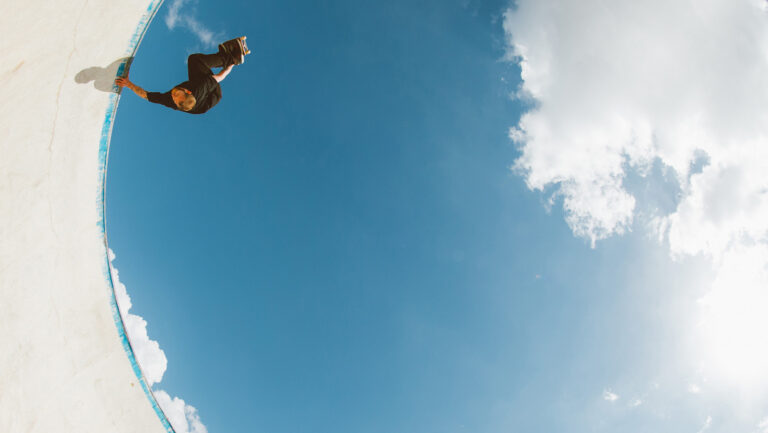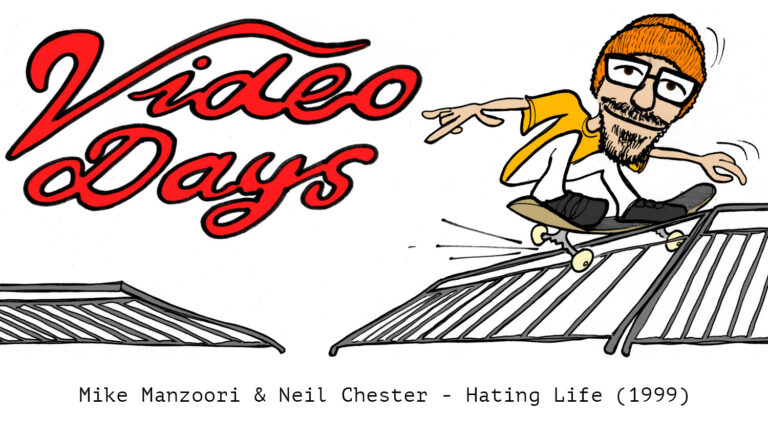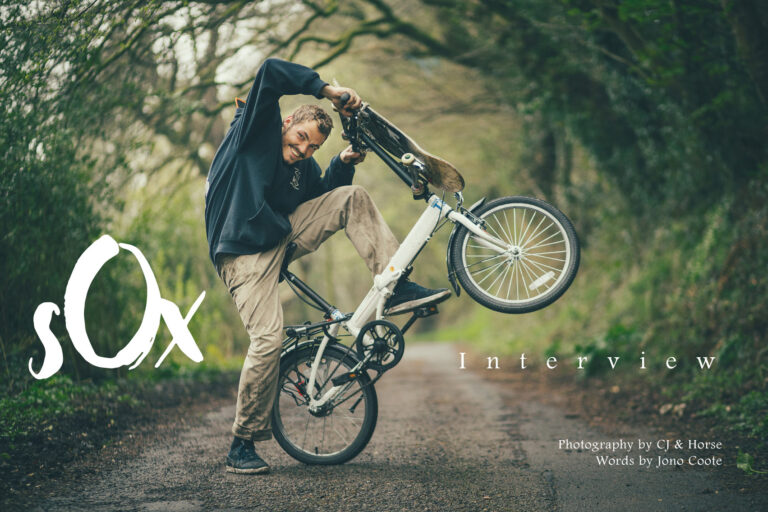Silas Baxter-Neal interview

Although he has been a staple member of Habitat Skateboards for over half of the brand’s life span, had multiple signature shoes with adidas skateboarding and taken Thrasher’s ‘Skater of the Year’ title in 2009; Silas Baxter-Neal is a skateboarder whose ability is sometimes understated. Perhaps it’s because Silas isn't plastered across social media. He prefers to dedicate his time to working on full-length video productions and magazine interviews, all while handling his most important job of all - being a father.
In an interview with fellow three stripe representative, Ian Michna described Dennis Busenitz thus, “If the world was ending, Dennis could probably throw his kids on his back, skate fifty miles outside of the city, build a cabin out of some old wood in the forest and protect his family” and I’m sure the very same could be said for Silas. With an established career and settled down with a wife and two children, it was interesting to gain a perspective on life from a person not discovering where skateboarding might take them, but with their life fully figured out. Read on to learn more about riding for Habitat Skateboards, his relationship with Joe Castrucci, and handling filming for ‘Away Days’ alongside family life in Oregon.
According to Joe Castrucci, you were living on someone’s floor in San Francisco when you started filming for Inhabitants [2007]. Is that how you remember it?
Oh yeah, when I was nineteen I moved from Eugene, Oregon to San Francisco and I was sleeping in my friend’s closet for a couple of months, (laughs). We ended up getting a house together eventually but it was a couple months of sleeping like that and saving money. That’s pretty typical of San Francisco though, I think everybody has that story at some point. I was just obsessed with skateboarding and that’s all I wanted to do. I worked a bunch of jobs in restaurants when I was a teenager throughout high school, and then afterwards I just wanted to be around that more and more. I was starting to get free stuff so I moved down to California to try and make it happen.
That Inhabitants section was your first video part with Habitat and also your first part in a full-length video for a company, right?
That was my first part with Habitat. I had a part in Thrasher’s Rocket Science [2004] when I moved down to San Francisco. I had some footage from Oregon left over and some stuff I filmed when I first moved down there. A friend was working for Thrasher and I was skating with him so he put together a little part for Rocket Science. Then I had some smaller production stuff before Inhabitants; my friend Adam Crew made a video I had a part in, Toebock [2003], and then a part in a local San Francisco video called Seasons [2004] that was put together by Trevor Prescott. Those were my first ones but Inhabitants was definitely my first big part.
Why is there more appeal to you in working on parts for full-length videos as opposed to solo web parts?
I’ve had a couple of things with adidas but I like making video parts more of a project as opposed to going out and seeing what we can get in a day. It’s fun to put more effort into it and take time with that so you put out your best. You know, quality over quantity. I think that when you work on a full video it puts more value into the skating itself, whereas a part for a quick web edit kind of lowers the value and makes it not as special. You work really hard on something, it gets seen really quickly and then it’s done and over with and there’s not much value to that. I like to think if you put a lot of work into something then it should be valued I guess, (laughs).
Would you say some of that preference is also because a part in full video better captures not just your skating but what was also going on in your life at that point?
That’s what I like about going back and watching videos. You work on something for two or three years and then look at the footage and remember all the trips, remember what tricks you were doing, what music you were into. It really is a snapshot of that time of your life and captures that pretty well, especially for your own self because you have those memories. Also, from the outside, a lot of your personality shows through so people can see what you were about at that time period.
I suppose that Inhabitants reflects you being young and generally carefree whereas with your last part in Transworld’s Perpetual Motion [2013], it’s the complete opposite end of the spectrum. You’re a lot more mature and have a family to handle skateboarding around.
I definitely think so, Inhabitants was about just going out skating as much as I possibility could and learning tricks; Perpetual Motion was more of a planned video part. Not because I knew what tricks I wanted to do but just, “I have this amount of time to do this” or “That month I’m on this trip.” I knew how long it was going to take to film for the video and how much free time I had so it was more about making the best of every spot and session.
Your sponsors seem to have a pretty mellow attitude towards social media. With the level of overkill in terms of the amount of footage released these days, do you feel the best way to present yourself is still the more ‘traditional’ method of video parts and magazine interviews?
I think it has a lot to do with the person them selves. Instagram works really well for a lot of people: especially the younger generations where they’re out skating a lot more. People want to know who they are and kind of the best way to know someone is through social media so by putting clips on your Instagram people can get a sense of who you are.
That works for kids but for me, I’m just not that into social media, and I don’t really have that much of an exciting lifestyle so I just don’t put up a lot of stuff on Instagram. It serves its purpose really well for some people but I’m just not too into it.
I’d imagine you’re usually pretty tied up, I mean I could hear your kids shouting in the background earlier.
(Laughs), you know honestly; I’m either at home with my wife, doing stuff with the family, hiking, fishing, doing something outdoors or I’m at my skatepark and that’s my life in Portland. Sometimes I’m out skating street and filming when it’s nice and beyond that when I’m on trips I’m skating as much as I possibly can. By watching a video part you see my skate life if you know what I mean? My home-life is my private life and I like to keep if that way, so it is what it is, (laughs).
Coming from Oregon what sort of appeal did Habitat, an Ohio-based company, have for you prior to getting on the team?
I think that Habitat has a real visual aesthetic. Habitat and Alien Workshop lead the way as far as video production, music and visuals. In Eugene, I was surrounded by a lot of people who are into music and arts so I grew up appreciating that whole side of things and that really appealed to me with Alien Workshop and Habitat.
Also, Eugene is kind of removed from the mainstream and I always felt like Alien and Habitat, by being in Ohio, have kept them selves out of the mainstream as well and have been able to do their own thing because of that. Not being too heavily influenced by what else is going on around them allowed them to be the unique companies that they are.
A lot of Castrucci’s art direction for the brand draws on old graphic design from around Ohio. Does Eugene, and Oregon in general, have that similar, old town feel to it?
Definitely, there are a lot of small towns in Oregon and there is that sense of mid-century design. The buildings and infrastructure is really from the 1950s and 1960’s. Because in the sense that they’re not really big cities they’ve not had those sorts of facelifts every ten years and have maintained that same feel of when they were originally developed.
I think a lot of that early design during the ‘50s, when people were going crazy with product and building design and all that stuff, a lot of that inspiration was really drawn from nature and their surroundings. That’s something that really shows through as well because Oregon was built upon logging in a lot of ways. People’s lives and inspiration were drawn from their surroundings, their work, their time and their business was all outside and around nature.
You moved back to Portland about five years ago, what brought you back?
I’ve always liked Portland and known that I would do well here. For a long time I was travelling, seeing other places and meeting people. Just trying to see what the rest of the US had to offer, connecting with that and entertaining the idea of living in different areas. When my wife and I decided to have a family, we wanted to be close to friends and family and be in a more comfortable environment than halfway across the US from everyone we knew. Subsequently, the place is good for similar ideals of how we want to raise our children. They have good schools here, good food, there’s good communities; I don’t know if when I made the move that was at the top of my list, but after having children I realised how important it was to have those things in your life.
What was the scene in Oregon like while you were growing up and how do you think it compares now to back then?
In Eugene we had a really tight knit group of friends. I grew up with Trevor Prescott and Tucker Glasow. There were some older dudes in Eugene that were really good, making their own videos and doing their own thing. We thought that was the way to do it so we made our own local videos, I think we made three or four before I ended up moving away. We were out filming and skating a lot as kids, there was a big group of us and we really pushed each other. Eugene is kind of isolated even though it’s like an hour and a half from Portland. We didn’t get up to Portland as much as you would think but we had so much to skate in Eugene we didn’t really need to.
Portland had a different scene. It was a little more connected with the California and now, when I look back, the scene has gone a bit separate. Cal’s Pharmacy was a big shop and they really helped keep the scene together with events, videos and things like that and right around the time I moved here they ended up closing their doors. They eventually have reopened their shop but there wasn’t a whole lot going on. I mean I guess there wasn’t a whole lot of the scene I recognised, I think that other people were doing things that I didn’t notice or pay attention to. There is a big skatepark scene up here as well, those dudes have their own thing going on and that’s awesome and there’s a big DIY culture. It’s kind of fast, there are a lot of things going on up here. Now, I have my little skate community, we have the skate park and skate street in the summer but it’s more about having fun.
You had some footage in Search The Horizon [2013] but Perpetual Motion was your last full video part and was filmed predominantly back home. Would you say it’s more of a natural process when you’re filming in Portland, or around Oregon, as opposed to going on trips?
I think most people film a lot in their hometown and what I think makes that part maybe seem unique is that there isn’t a great deal coming out of Portland. Me filming for Perpetual Motion was skating around with my buddies and going out on little missions here and there. Being able to do a lot at home provides me with more time at home. I don’t have to travel as much, which means I get to spend more time doing the things I want to do and be with my family. But then when I do go on trips I always try and get as much as I possibly can. I think I only went on one trip with the Transworld crew to Florida then I went on a couple of trips down to LA to film one on one.
That sounds like a big contrast to filming for the adidas video, Away Days. Those trips have been focused around very metropolitan cities such as London, New York, Barcelona and Tokyo for example. How do you find the scenes and vibes in those cities compare to skating back at home or the sort of places you would visit on Habitat trips?
Unfortunately I don’t spend long enough in any city to get to know the local scene super well aside from meeting some locals here and there. Usually on adidas trips we’re with a big group of dudes and we have our tour guides and just skate the city. Every city has it’s own scene, feel and aesthetic. They’re all very unique but I don’t know if I have a strong enough opinion about those scenes because I don’t know them very well.
Honestly, I think that skateboarding can get really lazy. You go to a big city, you go to the ten spots that city has and that’s your impression of the place even though there’s tons of other stuff. Oregon has tons of spots all spread out but I rarely make it outside of Portland to go skate any of them. I’ve travelled to Japan a bunch and no-one makes their way outside of Tokyo, or maybe Osaka, but there’s tons of amazing cities that all have amazing stuff to skate in them too. It’s more difficult to find those spots and people to take you to those spots; it’s just easier to stay within the centre of a city. Even Barcelona is an epic place to go skate but so is every city I’ve been to in Spain and all it takes is a train to get outside.
You celebrated ten years of riding for Habitat last summer and this year adidas skateboarding also reaches their ten-year anniversary. It’s hard to imagine you riding for anyone else, how has growing alongside those companies shaped your outlook on skateboarding?
I think Habitat has had an extreme influence on me as a person, and on my outlook on skateboarding. From when I was twenty years old to now I’ve been travelling, looking up to and being inspired by the same people. Seeing what they do, and the way they view skateboarding, has really rubbed off on me as well.
With adidas it’s the same thing. When you travel with people, spend a lot of time with them and watch the way that they skate that naturally influences who you are. It’s nice to be able to have a relationship with people long enough to be inspired by them. I think everybody is doing really cool stuff and it’s easy to notice the more flamboyant things right away, but it takes a lot of time around people to really understand them, their motivations, get those inspirations and be influenced by them.
Previously you’ve spoken about the effect bigger companies have had on skateboarding and how people, such as yourself, are able to have not just a career in skateboarding but comfortably own a house and support their family thanks in part to their shoe sponsor. Out of those brands adidas, though still a huge company, seems a lot more grass roots and subtle in their approach. Why do you think adidas comes across that way as opposed to some of the others of that size?
It’s a combination of things. I think a major part of it is down to Juice Design the company that develops all of their media; they do all the videos, adverts and a lot of trip planning. Team decisions and the decision-making processes are really intimately involved with adidas too. I feel their ideas and art really shows through. What you see when you see adidas is really their conceptions; you know what I mean? That’s just who they are. They’re humble people, they’re very art/image based, all about quality and doing things the right way.
It also it has a lot to do with adidas being a European brand and not having that large ego that I think is associated with America and American brands. Like, “We’re the best, look at us, look how loud we are, look how big we are!” you know what I mean? Honestly, even if you look at other sports, adidas has that feel and aesthetic as well. I think that Nike has that boisterous personality and although adidas has been around a long time, they’re just not as excited to show that and show it in other ways regarding skill and image.
One of the most notable moments with Habitat has been the trouble it has faced over the last few years. I think it’s really commendable that the whole team stood by Joe during that rough period. Obviously Austyn (Gillette) parted ways a little while beforehand but nobody left during that really rough time when the company actually went ‘under’. Having known him for such a long time, what is it about Castrucci that you feel made everyone want stick by him throughout that?
Joe is a very unique individual and he’s extremely driven and talented. To see that, to be part of that and to feel that what you’re doing is being represented by somebody like that is really important. Also, just the connection amongst the team; we all get along, we all want to be with each other and we all want to travel together. Only a couple of us live close, so going on trips is the only time we get to see each other so it’s really fun and exciting. A big reunion every trip. We all get along so well and are unique and similar at the same time that it’s cool to be on those trips.
But going back to Joe, I mean, Joe fought tooth and nail to keep Habitat alive. He’s done everything he possibly can. There have been some good moments and some really bad moments throughout the history but Joe has dedicated his life to it. To know that someone is doing that for something that you feel strongly about really makes it hard to think about being somewhere else. I don’t really see that kind of dedication in the other places and it’s incredibly inspiring and motivating.
Thankfully Habitat is going strong again and recently made the transition to Official Distribution from Tum Yeto. After everything the brand has faced with changing distributions in the past, how involved were the team in that decision?
Stefan (Janoski) has had a good relationship with Official for years and he knows (Jeff) Landi and the other owner pretty well. I think Stefan was a big part of making that transition happen. We all know Landi and Joe knows him real well. Through all the other transitions I had a lot of questions, then when Joe said, “We’re talking to Official” it just made sense. Also, I do trust Joe to ultimately make the best decisions for Habitat and for us as his riders.
Was the Regal Road [2005] Habitat tour the first time you visited England?
No, actually I came there for a Sidewalk trip, I think, with Pete Eldridge and Kerry Getz… That was like eleven years ago. That was one of my first international trips ever I think. One of the first times I ever went out of the United States and we went to Sheffield, Leeds and London.
You visited a few cities in the north of the country when you were over last summer, including Liverpool and Manchester, which both have very prominent scenes. Do you feel those places felt a lot different to London in anyway?
Yeah, they’re smaller cities and it’s much different. The people are much different, it’s a lot more rugged, the spots are a little rougher because you get worse weather and there isn’t as much money to fix things. I really enjoyed it though; it was cool to see a lot of spots I had never seen before. It just feels older and more classic. It reminds me of seeing old footage of (Geoff) Rowley and all those older English skaters. I like going to destinations that are a little more off the skate map in a way. I feel you get a more authentic experience because you’re just looking for what you can find. When you’re in Barcelona or China you get like a skate tour, you get ushered from one best spot to the next best spot.
We were in Liverpool for a day at the most and then we kept on going. That trip was kind of all over the place, we were playing it by ear. I think the weather was pretty hit and miss so we were just kind of like, “Where should we go next?” and kept on moving a bunch. I remember going to an old skatepark in Liverpool that was super crusty.
Edge Lane?
Yeah, exactly. Being there, just looking at it and seeing the ageing of the park was pretty incredible. I had a really good time in Manchester too with all the Black Sheep guys, that was a lot of fun. All in all it was a really fun trip. I really enjoyed that one.
Chris Mulhern is one of the main filmers behind Away Days and I know Castrucci has been a big influence on him. Do you feel there any similarities in their approaches?
Not especially, I see it in his edits but Chris is a very quiet person. Maybe it’s just our relationship but he doesn’t direct me, you know? We just go to a skate spot and film stuff together, there isn’t a whole lot of him directing me or me directing him so I don’t think that I see a whole lot of that but I do know the comparison and I see it in his edits. He has a very unique style of filming and editing that is his own and I think that we will really see that in this video. He’s taken a big part in editing, I know there are three main guys editing people’s parts and it’s kind of split up between the three of them so I think we will definitely be able to see which ones are Chris’, which are Justin Albert’s and which are Torsten Frank’s.
This is the first main video project you’ve been involved with for a shoe company, how has it differed to filming a full-length video for a board sponsor?
(Laughs), well I think the biggest difference on working with adidas than anything else is the budget which helps you go to where you want to go. For instance, I found out yesterday than I’m going to Japan on Monday, (laughs). We were just trying to figure out a last minute trip to go on, “It’s raining here, it’s raining there…” It develops so quickly but because we have a larger budget we’re able to go to more places and act more quickly because there’s more support. That wouldn’t be a possibility for a lot of other brands just because of finances I guess.
As you said, because it’s on so much of a smaller scale when working on something with Habitat: would you say that filming for a board brand is a more personal experience?
Yeah, at times for sure. I think this kind of answers an earlier question you had too but I feel that growing up, filming so much and going on so many trips with Habitat, Brennan (Conroy) and all those guys really shaped the way that I work. I’m pretty self-motivated and have a good idea of where things are, the kind of areas I like to skate, how to get there and how to make that happen. Even with Perpetual Motion, a lot of that stuff was on my own time. I planned my own trips and did it my own way and I think the same thing about this adidas video. I’ve been on some of the main trips that are more grandiose but at the same time I’ve been on a lot of smaller trips with just me and a couple of guys that are really self planned and driven. And that is really the style of Habitat. Just small crews, we go wherever and if it doesn’t work we pick up and go to the next town.
Do you like to be involved the editing process of your video parts?
I like to help pick music but I don’t like having the final say on any of that for a couple of reasons. I don’t think that I’m able to judge myself with enough of an outside opinion to put together something good. It’s hard to remove myself enough from that equation to look at it objectively. Also, the people who edit and make videos know what they’re doing. They know how that stuff works, the timing of parts, the music and the flow.
I try to pick music I like for my video parts but I don’t think that what I like always goes too well with skating and think other people aren’t going to view it the same way I do. Music is such an emotional thing. The reasons I like certain music aren’t always because of skateboarding or because it’s going to be motivating for skateboarding. A lot of it has to do with places, sounds and voices.
I’m guessing you spend a lot of time skating with Mark Suciu as you both ride for Habitat and adidas. How motivating is it being around a younger guy like Mark?
Mark is awesome to skate with. He does amazing tricks all the time and it’s also amazing to see the thought process that goes into those tricks. He also has a really good eye for spots and it’s nice skating with younger people in general because their outlook and views are completely different from my own. You get set in your ways and kind of stop absorbing as much from your surroundings. Those guys are so much more involved in modern skateboarding and what’s going on in the now that it’s nice to sit back, reflect and let that influence you as well because there’s great stuff from every generation.
There’s a lot of cool stuff going on now and I miss a lot because of whatever reasons so it’s cool to skate with Mark because he does tricks that I’ve never thought about or seen before. It’s cool to skate with Na-Kel (Smith) and Tyshawn (Jones) because they’re flying down stairs and keeping it a little more wild; that’s a really cool energy to pick up on, and skating with Miles (Silvas); he’s so calm, collected and good.
When you see somebody do something it allows you to understand that it can be done in a way. That’s why the next generation is always better but also, as the older generation, it’s good to see that because it gives you a little more confidence in what you can do.
Rounding this off, you’re in your thirties with a wife and children. How has getting older and having those responsibilities affected your attitude towards skateboarding?
That’s an interesting question, (laughs). That’s a hard question. I don’t think it has made it much harder but it has made me realise how much time I wasted beforehand. It’s amazing that once you become a parent, and you have these responsibilities, time is such an important thing. Trying to find time for all the things you want and need to do really kind of becomes your focus. Trying to find time for family, skating and all that stuff and you’re able to do it as long as you pay attention to it. Before, I didn’t even think about the concept of that so I would skate now and not skate then. Now I value my time to skate a lot more and when I do have the freedom to go on trips or go skate I really try and make the best of it, whether that means having a lot of fun or trying to get as much footage or whatever. Also, we have a private park up here and that’s been a tremendous help transitioning into the whole thing because that allows me a place to skate when it’s raining or dark. So, I can have the time to do these other things in life that I value.
Does it make you more concerned about injuries at all? You haven’t slowed down by any means and seem to jump down handrails more now than ever before.
The answer is yes, it does make me more concerned about injuries. Injuries take longer to heal when you get older which is part of how your body works. I broke my hand, I sprained my knee; this last year has been pretty full of injuries actually. But it also gives you something to do when you are hurt. When you have that downtime it’s not like you’re just sitting around waiting to skate, I’m doing stuff with my family. It gives you a chance to get away from that but it does make me more concerned about injuries in the fact that I do have these people to provide for. If I want skateboarding to be my source of revenue and my profession I need to keep producing at a certain level and if I get hurt it makes that a lot harder. Also, not living in California, I’m not able to be involved in the scene as much so I really have to put out enough skate stuff that people don’t forget about me, (laughs).
Thanks for your time Silas. Any plans for after Away Days is finished?
Take a breather, hang out. I don’t really have any projects on my horizon, which I’m totally cool with. I’d like to just keep skating, having fun, go with the flow and see where it takes me. I’d like to do more with Habitat, it’s been a long time since I’ve really been able to go on Habitat trips. adidas has been my main focus for a while so it would be nice to do a couple more trips with my other sponsors and see some people that I haven’t seen in a long time.

